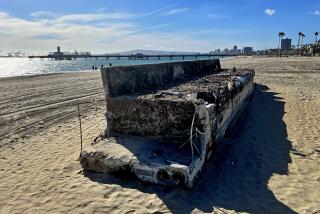Ocean’s nasty plastic garbage is disappearing: What’s going on?
Plastic seems to be disappearing from the world’s oceans, and scientists are not sure why.
Exposure to waves and radiation from the sun can cause plastics to break down into micro-fragments, but scientists say those fragments are stable and durable enough to last for hundreds of thousands of years.
And yet, in a new study published in the Proceedings of the National Academy of Sciences, a team of researchers report there is between 10,000 and 35,000 tons of plastic debris floating on the surface of our oceans -- significantly less than they expected to find.
After analyzing 3,070 samples of seawater from around the world, the researchers found that there has been no significant increase in the amount of plastic in the surface water of the world’s oceans since the 1980s, even as the amount of plastic produced worldwide has more than quadrupled.
More plastic in the world almost certainly means more plastic in our oceans. But if the buoyant plastic is not floating on the surface, where is it?
Members of the research team, lead by ecologist Andres Cozar of the University of Cadiz in Spain, don’t claim to have the answer, but they do identify a few clues for future science detectives to follow up on.
For example, they found far fewer fragments of plastic debris 5 millimeters and smaller than their computer models predicted. That led them to conclude that it is probably the smallest pieces of plastic that are making their way deeper into the water.
The authors say mesopelagic fish, which live in the hazy twilight zone 660 to 3,300 feet beneath the ocean’s surface, may be mistaking these bits of plastic for zooplankton of the same size. Perhaps the fish are gobbling them up at night when they come to the surface to feed, and then bringing the plastic back down to the deeper ocean where they spend most of their lives.
Over time, the plastic may sink deeper when excreted or when the fish dies.
The researchers also note that recent studies have shown bacterial populations growing on plastic microfragments, weighing them down and causing them to sink.
But these are just a few possible answers to the missing plastic question, and the authors note that there are probably others.
Angelicque White, an ocean ecologist at Oregon State University who was not involved with the study warned that it is very hard to get a rock solid reading on what might be going on with plastics and our oceans.
“Plastic is widely distributed throughout all ocean basins, but the concentrations are really patchy from spot to spot and hot spots are driven by ocean circulation,” she said in an email.
She added that we still have a lot to learn about how plastic functions in the ocean. “Microbes thrive on plastic; plastic is habitat; plastic is eaten by organisms,” she wrote. “It is not clear at all if this is always harmful or if most of the ingested plastic is passed.”
Dianna Parker, a spokeswoman for NOAA’s Marine Debris Program, said studies like this one can help inform her group’s future work.
“Every study we see that comes out gets us a little closer to the answers on the marine debris problem,” she said. “It is such a new problem, so studies like this help us figure out where to focus our efforts.”
For more amazing science news, follow me @DeborahNetburn







